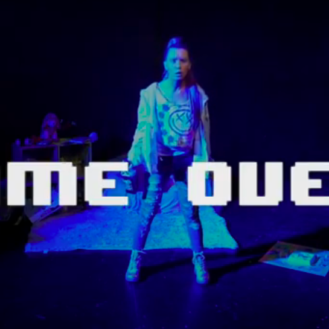There’s a lot of ambiguity at foot in Jane Schoenbrun’s We’re All Going to the World’s Fair and, for some, the film will offer too many “inconclusive” story threads. However, that ambiguity is what makes Schoenbrun’s movie creepy and disturbing, and opens the film up to various discussions about selling your life to the Internet.
The World’s Fair challenge is an online horror role-playing game created by Schoenbrun who was inspired by various “creepypasta” lore, such as “unauthorized games” created by anonymous online users using the infamous Slender Man persona. What starts on the Internet as a creepy campfire story has manifested over to controversial news stories that absorb impressionable kids and teens. Such is the case for Casey (played by Anna Cobb, in a phenomenal debut).
Throughout the film and aside from one crowd scene as a wallflower, Casey has no connection to anyone. In a brilliant move by the filmmaker, we only hear Casey’s father once off-camera, telling her to keep the noise down in her room. This isolation is why she gravitates towards the temptation of the World’s Fair challenge. For her small vlog audience, she states she wants to take part in the World’s Fair challenge because she wants to feel like she’s in a horror movie (the Candyman-esque challenge requires participants to chant “I want to go to the world’s fair” while staring into their webcam, followed by pricking their finger). However, movie goers can see that this is a cry for help and an attempt to socialize with “anything”.
Her vlogs get the attention of a user with the pseudonym “JLB” (played by Michael J. Rogers), who eventually reaches out to touch base with Casey. First, to gab about “the game” and its effects, and then these chats turn into wellbeing checks unbeknownst to Casey. However, the audience is never quite sure of JLB’s intentions. Especially when his calm demeanour is paired with a terrifying avatar that looks like the Babadook’s younger brother. JLB also reaches out to Casey initially through an extremely unsettling video featuring a distorted screenshot of Casey with her eyes and mouth removed.
We’re All Going to the World’s Fair taps into the audience’s concern and empathy for Casey through an unpredictable narrative. While we initially stick with Casey, Schoenbrun will occasionally send viewers down a “related videos” rabbit hole featuring unknown users who are addicted to the game and others who are more interested in theorizing about what the World’s Fair is through short films. The audience is even traded off to JLB at one point, and Casey is treated as another related video in the online algorithm. This bait-and-switch is in full effect when Casey starts becoming very vulnerable. The more we’re disassociated with Casey, the more we’re freaked out.
We’re All Going to the World’s Fair has been billed as a horror, and it certainly is. However, it’s not a horror movie in the traditional sense (no jump scares, for instance). But with deliberate awkward pacing and a sense of floating through the online ether, Jane Schoenbrun does find restless fear in Casey’s journey and delivers an unforgettable and compassionate movie.
**********
Do You Tweet? Follow These Tweeple:
Addison Wylie: @AddisonWylie





Be the first to comment